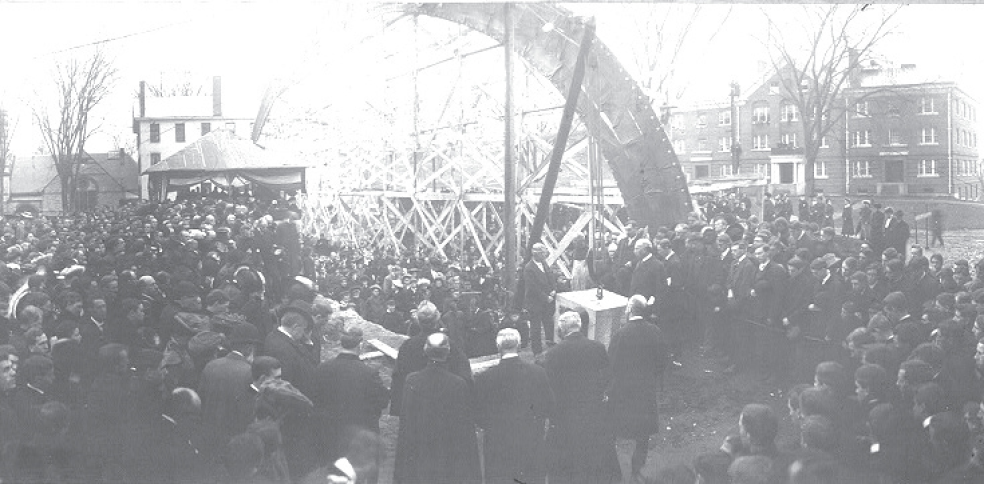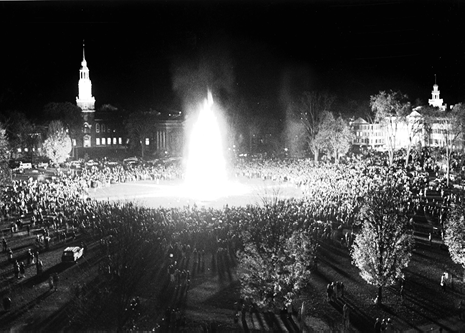This Friday is Dartmouth Night, an evening of tradition impressive even by Dartmouth College standards. It kicks off the traditional Homecoming weekend with an evening of speeches, a parade, and, of course, the famous bonfire. For over one-hundred years, Dartmouth students, alumni, and—ahem—administrators have reveled in the camaraderie, good cheer, and College spirit. For instance, Douglas Vanderhoof, of the Class of 1901, wrote home to his parents about Dartmouth Night during his freshman year, declaring: “This is one of the best nights for years … and of course great enthusiasm was aroused.” Though much has changed since then, the classic spirit of the legendary fire remains.
The origins of the Dartmouth Night fire trace back over a century. In 1888, students from all four classes built a bonfire of cordwood from the forests around the College to celebrate a baseball victory over Manchester, 34-0. An editorial in The Daily Dartmouth criticized the fire, saying “It disturbed the slumbers of a peaceful town, destroyed some property, made the boys feel that they were being men, and in fact did no one any good.” Nevertheless, the idea remained popular, and the bonfires continued informally, both before athletic events and in celebration of victories. These bonfires frequently included an outhouse as part of the fuel for the fire. Five years later, the College officially recognized the fires.
Seven years after the fires began, President William Jewett Tucker introduced the ceremony of Dartmouth Night. On September 20, 1895, the first Dartmouth Night was held to celebrate the accomplishments of the alumni of the College and, in Tucker’s words, “to promote class spirit and … initiate freshmen into the community.” The Daily Dartmouth described it as an event in which students were “addressed by representative alumni who illustrate the success and ability of Dartmouth graduates.” However, less formal sources relate that the evening tended to be composed of torturously long speeches. Fortunately, over time the speeches came to compose a smaller part of the ceremony, and other events became more prominent.
Dartmouth Night became part of President Tucker’s self-conscious effort to strengthen and deepen what he called the “Dartmouth Spirit.” Or, as he put it another time, it was a way to “capitalize the history of the College.” At Dartmouth Night in 1896, Richard Hovey’s “Men of Dartmouth” was elected as the best of all the songs of the College. In 1901, the evening served as a celebration of the hundredth anniversary of Daniel Webster’s graduation (and so students were, naturally, dressed in eighteenth-century costume for the occasion).
Probably the most famous Dartmouth Night occurred a bit more than a century ago when William Heneage Legge, the Sixth Earl of Dartmouth and direct descendent of the British noble who provided most of the original capital for the College, visited the campus. The occasion was both dire and celebratory. In February, the old wood-post Dartmouth Hall had burned to the ground in a matter of minutes. The Earl was here to lay the cornerstone for the modern recreation that stands on the same ground today.
Thousands of alumni came to town for the event, gathering underneath a huge electric arch over the length of the Dartmouth Hall site, making brilliant the words, “1791—Dartmouth—1904.” The Earl rose and said, “President Tucker is the head of the family of Dartmouth on this side of the water, as I am of the one on the other side. His family is larger than mine, but I do not believe that I envy him in this respect.” He continued: “I do believe, however, that his hope and ambition for his family are identical with mine, that the sons of Dartmouth, whether they be many or few, may be God-fearing men and an honor to the name they bear.”
Royal Parkinson, of the Class of 1905, an undergraduate at the time, remembered: “When that came from his heart as you could see that it did, and as it must have since he was called on unexpectedly, old alumni and guests on the platform jumped up and waved their hats, and an alumnus called for a cheer for Lord Dartmouth. We almost had tears in our eyes, but we gave the two loudest cheers that ever shook the walls of a building. After that, the cornerstone was a small part of the occasion.”
The Earl’s visit on Dartmouth Night was, as a matter of course, celebrated with an enormous bonfire. But the students were not content with the traditional fire alone. In order to make a vivid impression on the visiting Earl and his companion, a young Winston Churchill, the students formed a parade. The Earl took up the lead, and the students, dressed in their pajamas, marched around the Green. The traditional herding of the freshmen around the bonfire was inaugurated.
In 1907, the orations were moved from their original home in the chapel of Dartmouth Hall to the newly completed Webster Hall. The celebration continued to be a big event for alumni. Alumni groups from all over the nation converged on Hanover for the festivities. For those who were unable to attend in person, radio links were established to let clubs all over the nation listen to the speeches and partake vicariously of the revelry, and it was popular for the clubs to send telegrams to Hanover for reading at the ceremonies.

Football first began to be associated with Dartmouth Night in the early 1920s. Memorial Field was dedicated on Dartmouth Night in 1923. The raucous pre-football rallies, though, remained quite separate from the somber official activities. In 1936, the College first began the tradition of Homecoming games.
Football, though, had always been an integral part of the Dartmouth experience. Professor Edwin J. Bartlett, of the Class of 1872, remembered in his little volume A Dartmouth Book of Remembrance: Pen Sketches of Hanover and the College Before the Centennial and After (1922): “Football was simplicity itself. You ran all over the campus, and when, as, and if you got the chance, you kicked a round rubber ball. You might run all the afternoon and not get your toe upon the ball, but you could not deny that you had had a fair chance, and the exercise was yours and could be valued by the number of hot rolls consumed at the evening meal.”
Bartlett was clear on the value of football: “It was glorious for exercise and had enough excitement to make it highly interesting. It gave ample opportunity for competitions in speed, finesse, dodging, endurance, and occasional personal collisions.” However, not all agreed: “For a year the faculty in its inscrutable wisdom debarred this highly useful game because of abuses, as they thought, in the manner of playing it.” While an undergraduate, Bartlett was a member of the student committee that successfully petitioned the faculty to reinstate football at the College.
And like all of Dartmouth’s big weekends, Homecoming became in many ways an excuse to import women to the College. In the days before coeducation, when Hanover was far more of an outpost than it is today, Homecoming was one of the first times that women from nearby women’s colleges like Smith, Wellesley, etc., would be invited onto campus.
During World War II, the celebrations were scaled down markedly. In 1943, President Ernest M. Hopkins presided over only a small gathering in Thayer Hall. However, following World War II, Dartmouth Night enjoyed a resurgence of popularity.
In 1946, the formal College events and the unofficial rally were combined in a single grand event, and for the first time the festivities were intentionally scheduled on the weekend of Homecoming. In the 1950s, the current hexagonal construction of railroad ties was first used. Since then, the weekend has undergone a number of changes, but its essence remains.
Often, the tradition has been interrupted or sullied by mischief, violence, or act of God. In 1954, the bonfire was canceled due to an impending hurricane, and, in 1963, a drought raised concerns about a major fire, which led to the cancellation of the bonfire. From 1969 to 1972, campus political sentiment was such that there was no official celebration of Dartmouth Night. In 1976, student radicals lit the bonfire prematurely, as it was under construction, for political causes. In 1987, a dissident group calling itself “Womyn to Overthrow Dartmyth” and the “Wimmin’s International Terrorist Conspiracy from Hell” dressed as witches and threw eggs at the podium during the addresses. And in 1992 and again in 1997, the freshman sweep degenerated into full-scale rioting, with downtown Hanover laid waste.
Despite change, Dartmouth Night and the ensuing games of Homecoming weekend still provide the ideal opportunities for all members of the College community to show their dedication to Dartmouth, lest the old traditions fail.
This set piece to The Review’s Homecoming coverage was written by Joseph Rago and has been reedited.

